Objective
The University of Tennessee Health Science Center requires that its employees observe and practice safe driving in State of Tennessee owned or leased vehicles.
Scope
This shall apply to all employees in all departments on the University of Tennessee Health Science Center campus who operate UTHSC owned or leased vehicles.
This policy includes general requirements, maintenance, monitoring compliance and safe operation of vehicles. This policy does not include the operation of Low or Medium Speed vehicles which will be covered in separate policy.
Roles
Departments shall:
- Orient all new UTHSC drivers upon assignment to driving positions. Orientation shall include discussion of this policy, specific departmental policies, and any additional vehicle-specific requirements.
- Offer or schedule additional training as required ensuring the safe operation of specially equipped vehicles.
- Take appropriate action against UTHSC drivers who fail to comply with the Motor Vehicle Safety Policy.
- Ensure employees complete and sign the UTHSC Vehicle Use Acknowledgement form and an Acknowledgement of Policies Governing the Operation of University Vehicles and submit to Fleet Management.
- Ensure employees are informed that the University’s liability coverage applies only to vehicles driven by UTHSC employees within the course and scope of their employment and only while on University business.
Employees who operate UTHSC vehicles shall:
- Maintain a valid driver’s license.
- Comply with all appropriate sections of this policy, including reporting procedures.
- Be at least 18 years old.
- Have at least 3 years of driving experience if operating vehicles for the specific purpose of transporting passengers.
- Operate UTHSC vehicles in a safe manner as outlined in the policy and required by state law.
- Report to their supervisor any changes in medical condition that may affect their driving.
- Report any loss of driver’s license to their supervisor no later than the next business day.
Supervisors shall:
- Ensure employees have read the Motor Vehicle Policy, have signed all pertinent forms and follow all rules and regulations pertaining to motor vehicle use on campus.
- Complete UTHSC procedures concerning Workers Compensation and Risk Management (E.g. Notify supervisor, contact CORVEL, complete Incident Report) if an employee is hurt while driving, or riding in a UTHSC owned vehicle.
Abbreviations, Acronyms, and Definitions
- CS: Campus Safety
- UTHSC Vehicles: Vehicles owned or leased by UTHSC by which persons or property may be transported. These include some specially equipped vehicles that may not be licensed for road use to include, but not limited to, golf carts, forklifts, grounds equipment and others.
- UTHSC Driver: A person who is authorized to operate a UTHSC vehicle including employees, students, volunteers, and contract employees.
- Commercial Motor Vehicles: Vehicles owned or leased by UTHSC which meet the following criteria in accordance with Part 383 of the Federal Motor Carrier Safety Regulations:
- Vehicles whose gross vehicle weight or gross combined vehicle weight exceeds 26,000 pounds.
- Vehicles designed to carry 15 or more people (including the driver).
- Vehicles that carry hazardous materials required by Federal law to be identified with hazmat placards.
- Commercial Driver’s License (CDL): A license issued by a state to an individual who resides in the state that authorizes the individual to drive a class of commercial motor vehicle.
- Low Speed Vehicle: Low speed vehicles that meet certain statutory requirements may be titled and registered in Tennessee for use on roads with a speed limit of thirty-five miles per hour (35 mph) or less. Generally, golf carts are excluded, unless they are specifically designed and manufactured for on road use or have been modified.
- Medium Speed Vehicle: Medium speed vehicles that meet certain statutory requirements may be titled and registered in Tennessee for use on roads with a speed limit of forty miles per hour (40 mph) or less.
Procedure
Hiring Practices for “Frequent Drivers”
The following requirements in this section apply to “frequent drivers”, defined as those employees whose job description requires they operate a UTHSC vehicle.
- Current valid driver’s license
- No DUI convictions, reckless driving convictions, suspensions or revocation of license within the past five years.
- The number and type of moving traffic violations and/or at fault accidents may also be cause not to extend an offer of employment for or termination from a position that requires operation of a UTHSC vehicle.
Human Resources shall
Verify the above requirements prior to a final offer of employment by UTHSC. Documentation shall be maintained in the employee’s employment file.
Driving Record Verification Requirements
All UTHSC employees who are required to operate a UTHSC owned or leased vehicle in the course of their employment with UTHSC shall disclose convictions for the following offenses that have occurred within the past five years regardless of location:
- DUI
- Reckless driving
- License suspension or revocation
- A second speeding citation within a rolling twelve (12) month period
Employees required to operate a UTHSC vehicle that have been convicted of any of the above listed offenses within the last five years may be prohibited from operating a UTHSC vehicle.
General Requirements for Motor Vehicle Operation On UTHSC Campus
- UTHSC vehicle operators must carry a valid motor vehicle operator’s license. Under no circumstances shall an employee whose license is revoked, suspended, expired, or otherwise invalidated operate a motor vehicle for official state business.
- When required, the license must have the appropriate commercial endorsement.
- For employees who are required to maintain a valid driver’s license as part of their official duties, driving record convictions may be considered as grounds for disciplinary action, up to and including dismissal, whether the offenses and infractions occurred during or outside work hours. This includes driving under the influence as defined in Tenn. Code Ann. § 55-10-401.
- Any employee whose position requires a valid driver’s license as a job qualification shall advise his or her supervisor within twenty-four (24) hours of the employee’s next scheduled workday of any conviction, suspension, revocation, expiration, or invalidation of the employee’s driver’s license. Failure to notify the supervisor of any such conviction, suspension, revocation, expiration, or invalidation may be cause for disciplinary action, up to and including dismissal
- UTHSC employees who are required to drive UTHSC owned vehicles, shall do so legally, safely, and defensively. Employees are required at all times to comply with any and all laws when operating any motor vehicle on official UTHSC business.
- Employees shall follow any restrictions that are a condition of the employee’s license (e.g.use of corrective lenses where necessary).
- UTHSC’s liability coverage applies only to vehicles driven by UTHSC employees within the course and scope of their employment and only while on University business. No personal use is allowed.
Vehicle Operation Requirements
Employees are required to complete and sign a UTHSC Vehicle Use Acknowledgement form and an Acknowledgement of Policies Governing the Operation of University Vehicles and submit to Fleet Management. The forms are found in Appendix A and can also be found in the UT System Fiscal Policy FI0725.
- Seat belts shall be worn by the driver and all passengers in UTHSC vehicles, in accordance with all applicable Tennessee State laws.
- UTHSC vehicle operators shall not use cell phones, personal digital assistants for calls or texting or engage in other distracting activities while the vehicle is in motion.
- UTHSC Police shall adhere to their internal policy on this issue.
- Smoking in UTHSC vehicles is prohibited.
- With the exception of UTHSC Police, no employee shall carry a firearm or other weapon while in a UTHSC vehicle.
- This prohibition on carrying weapons shall include individuals who are authorized to carry a concealed weapon in accordance with the Tennessee Code Annotated (TCA) 39-17-1315.
- All employees operating a UTHSC vehicle shall obey all traffic laws of the jurisdiction they are driving in. There is an exception for UTHSC PD emergency vehicles.
- Departments shall ensure the safe operation of vehicles during adverse weather conditions by providing ancillary equipment such as mud/snow tires, chains, extra lights, ice scrapers or other safety equipment designed for a particular vehicle.
It is the responsibility of all vehicle operators to drive in a safe manner and to conform to all applicable laws and regulations. In addition, vehicle operators are responsible for the conduct and actions of all passengers riding in the vehicle. Vehicle operators will:
- Obey all traffic signs, speed limits and other warning devices.
- Not engage in any activity involving the use of hands other than those actions necessary to operate the vehicle or necessary for required communication. This includes, but is not limited to: using a cell phone, eating, drinking, smoking, reading, etc.
- Not wear radio headsets, ear buds, earphones or similar devices or listen to audio equipment that would prevent them from hearing traffic warning devices or distract them from their driving duties while in State owned vehicles.
- Use proper directional signals when turning.
- Ensure visibility by scraping and/or defrosting windows and mirrors as necessary.
- Adhere to UTHSC signs & policies when parking a UTHSC vehicle. UTHSC vehicles may park only where authorized. UTHSC vehicles may not park on yellow markings, in fire lanes, reserved spaces, and handicapped spaces or on the landscape or sidewalks. This would not be applicable in emergencies (i.e. UTHSC Police and other emergency vehicles), as well as loading and unloading large equipment.
- Ensure that the vehicle is secured when parked by:
- Turning the ignition switch off
- Removing the key.
- Engaging the hand brake or the parking brake.
- Using wheel chocks if provided, or “curbing” the wheels of the vehicle when parked on an incline.
- Locking the vehicle if left unattended.
- Adhere to the following rules while engaged in backing a vehicle:
- Before attempting to move, determine that backing will not endanger pedestrians, other vehicles, other objects or the vehicle being moved
- If backing where space is limited, seek additional outside-the-vehicle help if available.
- Back slowly.
- Use both interior and exterior mirrors, checking both sides as the vehicle backs up
- Ensure the safe transport of materials and goods by:
- Securely fastening all loads, regardless of weight or height, to prevent rolling, pitching, shifting or falling. No one will be allowed to physically “steady” the load while riding in the back of the vehicle.
- Securely fastening all doors while the vehicle is in operation.
- Securing tailgate in an upright position while the vehicle is moving except when the load exceeds the length of the bed of the vehicle.
- Affixing a red flag to the end of any load that extends four feet or more beyond the end of the vehicle or loads that extend beyond the width of the vehicle.
- Utilizing a tarpaulin or other cover to cover loads of loose materials such as sand, gravel, or trash.
- Utilizing the proper loading docks or areas at each building.
- Ensuring that barriers installed in all enclosed vans to separate the cargo and passenger areas are secured and will protect the driver and passengers from injury should the load shift during transport.
- Ensure the safe transport of hazardous materials.
Note: The US Department of Transportation classifies hazardous materials into the following groups: Explosives, Flammable Materials, Compressed Gases, Oxidizers, Poisonous Materials, Corrosive Materials and Radioactive Materials. Transportation of these materials is strictly regulated to protect people, property and the environment by minimizing the possibility of a hazardous materials release. Anyone transporting these materials for UTHSC should contact Campus Safety at 448-1334 prior to transport to ensure compliance with the applicable regulations.
Prohibited Practices
- Allowing any passenger to ride in the bed of the vehicle or to sit on the tailgate or sides of the vehicle, or allowing passengers to extend their arms or legs beyond the vehicle while it is moving.
- Allowing any passenger to ride in a trailer while it is being towed.
- Allowing the number of passengers to exceed the number of seat belts (except for buses).
- Allowing any passenger to ride between bucket-type seats, on the engine cowling or on a chair placed between the seats and not affixed to the floor.
Vehicle Maintenance
Proper vehicle maintenance is an important part of fleet safety. Employees must report vehicle maintenance problems to Fleet Management during the shift in which the problem was noted. If the vehicle is leased, the problem shall be reported to the lessor by Fleet Management. Maintenance issues related to safety (e.g. brakes) shall be reported as soon as possible to Fleet Management. Preventative maintenance shall be performed on vehicles in accordance with the manufacturer’s specifications. Fleet Management will establish a process to schedule and document maintenance on UTHSC vehicles.
15 Passenger Vans
Vans with seating for 15 passengers, or more, present unique safety challenges. The following additional requirements apply to individual who are operating 15 passenger vans.
- Review National Highway Traffic Safety Administration (NHTSA) Passenger Van informational:
- Operators of 15 passenger vans must be at least 21 years of age.
- Tire pressure must be checked at least once/week using the manufacturer’s recommended pressure levels.
- 15 Passenger vans shall have:
- National Highway Traffic Safety Administration’s (NHTSA) “Reducing The Risk of Rollover Crashes in 15-Passenger Vans” Hangtag (Appendix D)
- “Reducing The Risk of Rollover Crashes in 15-Passenger Vans” Flier in each van (Appendix E).
- Van should be operated during daylight hours only. If the trip is likely to exceed 400 miles in a single day, another driver must be available.
- Operators of 15 passenger vans must take a break at least every four hours of driving time.
Accidents
Any incident involving a university vehicle operated out of state should be reported immediately to the Office of Risk Management. See FISCAL POLICY FI0135 for instructions on reporting accidents and claims.
An accident report form is included in UTHSC vehicles and shall be used in the event of an accident. Appendix F contains an example, and can be provided by Fleet Management.
The following procedures shall be followed after an accident has occurred:
- Stop the vehicle immediately at the scene of the accident, but in a safe location.
- DO NOT ADMIT FAULT. It’s sometimes difficult in the immediate aftermath of an accident to determine what happened. Let the appropriate officials and/or investigation determine the reason for the accident.
- Summon emergency medical services if injuries are apparent.
- Notify the local law enforcement agency if the accident occurred off campus and on a public road. The employee’s supervisor shall be notified as soon as possible but no later than the end of the work shift. The supervisor shall then notify the following individuals before the end of the work shift:
- Fleet Management Phone 448-5857
- UTHSC Police Phone 448-4444
- Campus Safety Phone 448-1334
If the accident occurred on campus, notify all of the above.
If the accident occurred on private property (e.g. store parking lot), document the event to the extent feasible using Appendix C.
- A blank form should be kept in UTHSC vehicle glove boxes with completed copies sent to the Fleet Management. The form can also be found within the link in Appendix C.
If an employee is injured, it is the employee’s obligation to complete the proper Workers Compensation and Risk Management procedures as required by Human Resources.
Recordkeeping
Departments should maintain records of signed copies of the UT System Fiscal Policy FI0725 Acknowledgement of Policies Governing the Operation of University Vehicles form (Appendix F), and copies of the Driver’s Report of Vehicle Accident (if applicable).
Human Resources should maintain copies of employee driver verification records and documentation in the employee file.
Training
Employees who routinely operate a UTHSC vehicle shall receive training. The type, content, and frequency of training shall be determined by Fleet Management.
At a minimum, UTHSC employees who operate a UTHSC motor vehicle shall be required to read this policy. In addition, drivers may be required to participate in training as may be required by UTHSC’s insurance carrier.
All training shall be documented and maintained in either the vehicle operator’s file or the department’s file. These records shall be maintained for a minimum of three years. Campus Safety offers training specifically for Van Drivers and Alternative Vehicles. Please contact Campus Safety for more information.
- Upon request, Human Resources shall provide Fleet Management with the names of new employees whose job requires them to drive a UTHSC vehicle.
Responsible Official & Additional Contacts
|
Subject Matter |
Office Name |
Telephone Number (xxx) xxx-xxxx |
Email/Web Address |
|
Policy Clarification and Interpretation |
Campus Safety |
901-448-6114 | |
|
Policy Training |
Campus Safety |
901-448-6114 |
Attachments
- Appendix A – Acknowledgement of Policies Governing the Operation of University Vehicles
- Appendix B- Vehicle Use Order Form
- Appendix C-Driver’s Report of Vehicle Accident
- Appendix D – “Reducing The Risk of Rollover Crashes in 15-Passenger Vans” Hang Tag
- Appendix E – “Reducing The Risk of Rollover Crashes in 15-Passenger Vans” Flier
Associated Standards
- UT System Fiscal Policy FI0725: Use of University Vehicles
- Occupational Safety and Health Administration (OSHA) Regulations
- Federal Motor Carrier Safety Regulations
Appendix A
THE UNIVERSITY OF TENNESSEE
Ut Fi 0725: Acknowledgment Of Policies Governing The Operation Of University Vehicles
http://policy.tennessee.edu/fiscal_policy/fi0725/
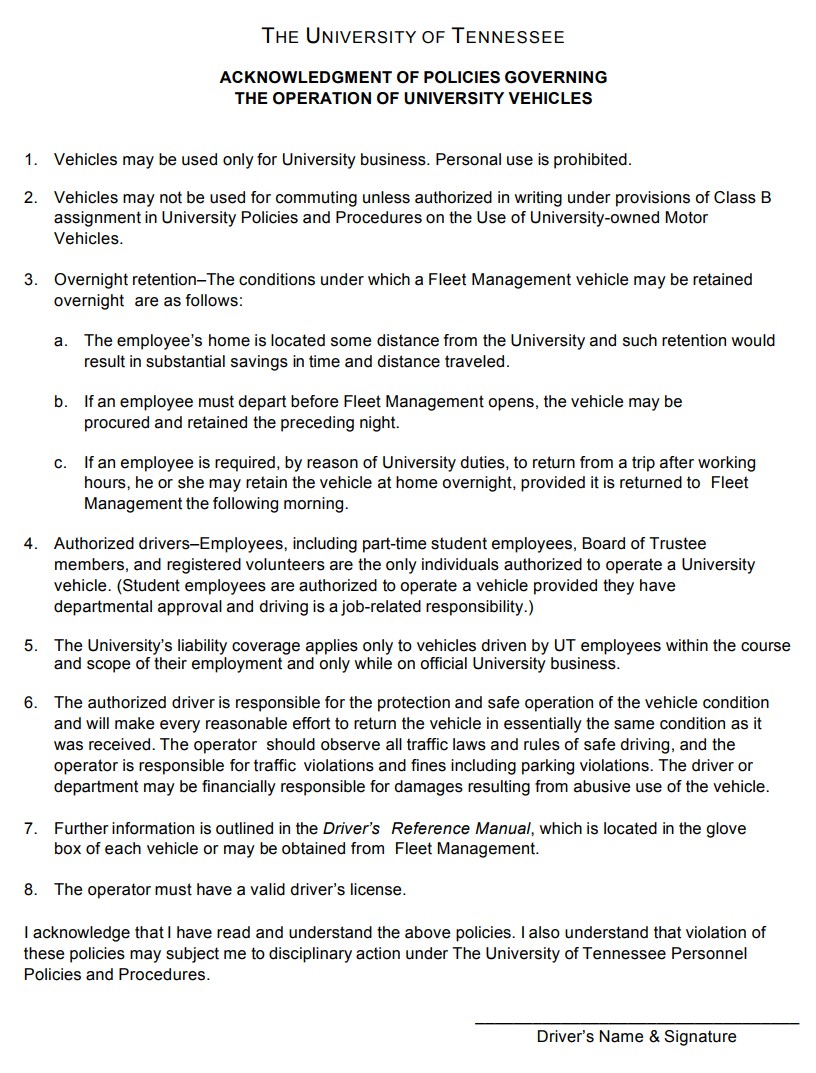
Appendix B
The University of Tennessee Health Science Center Vehicle Use Order Form
Vehicle assignments are made to departments for an indefinite period or on a trip-by-trip basis, depending upon the transportation needs in accordance with this the rules set forth by UTHSC Fleet Management, and UT System Policy FI0275 under “Assignment of Vehicles” para 3.
In all cases, requests for use of UT owned or Leased vehicles will be completed at UTHSC Fleet Management by utilizing the Vehicle Assignment Request/Authorization form (or equivalent).
This form is located at the UTHSC Fleet Management Office, and may change content as it is a locally generated document.
Driver’s Report of Vehicle Accident
http://riskmanagement.tennessee.edu/Driver’s%20Report%20of%20Vehicle%20Accident%20Form..pdf
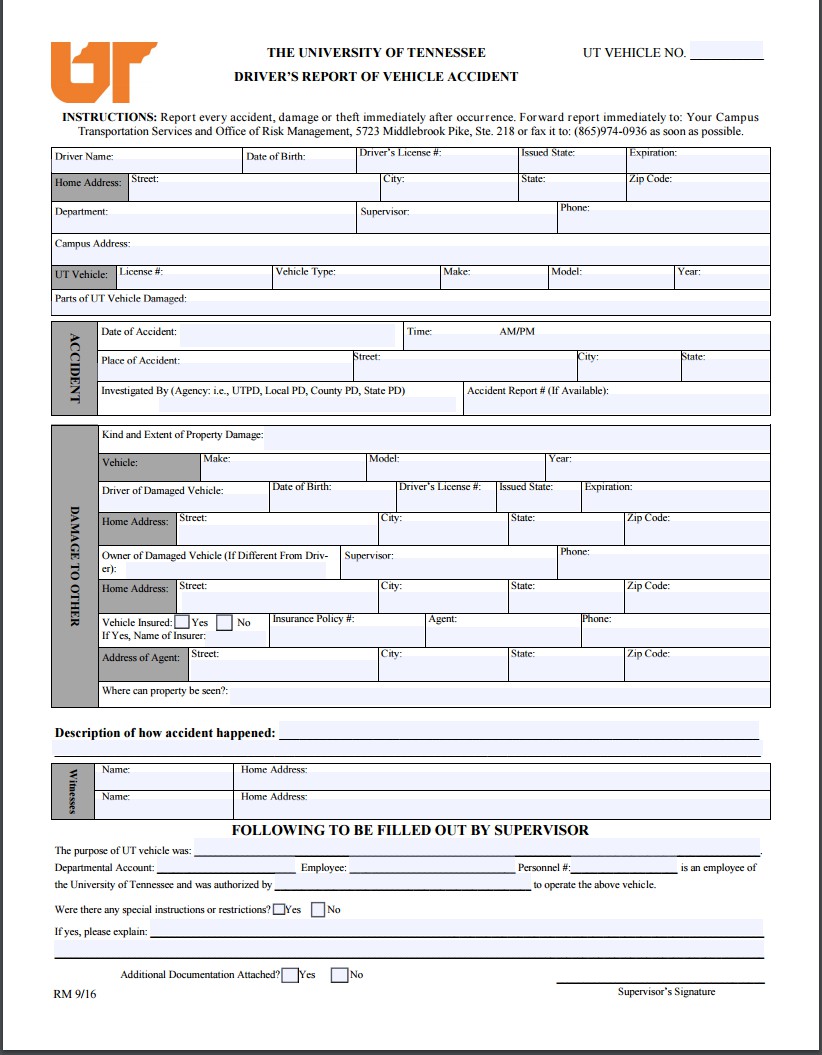
“Reducing The Risk of Rollover Crashes in 15-Passenger Vans” Hang Tag
http://www.safercar.gov/staticfiles/safercar/Passenger%20Van%20Safety/vanhangtag.pdf
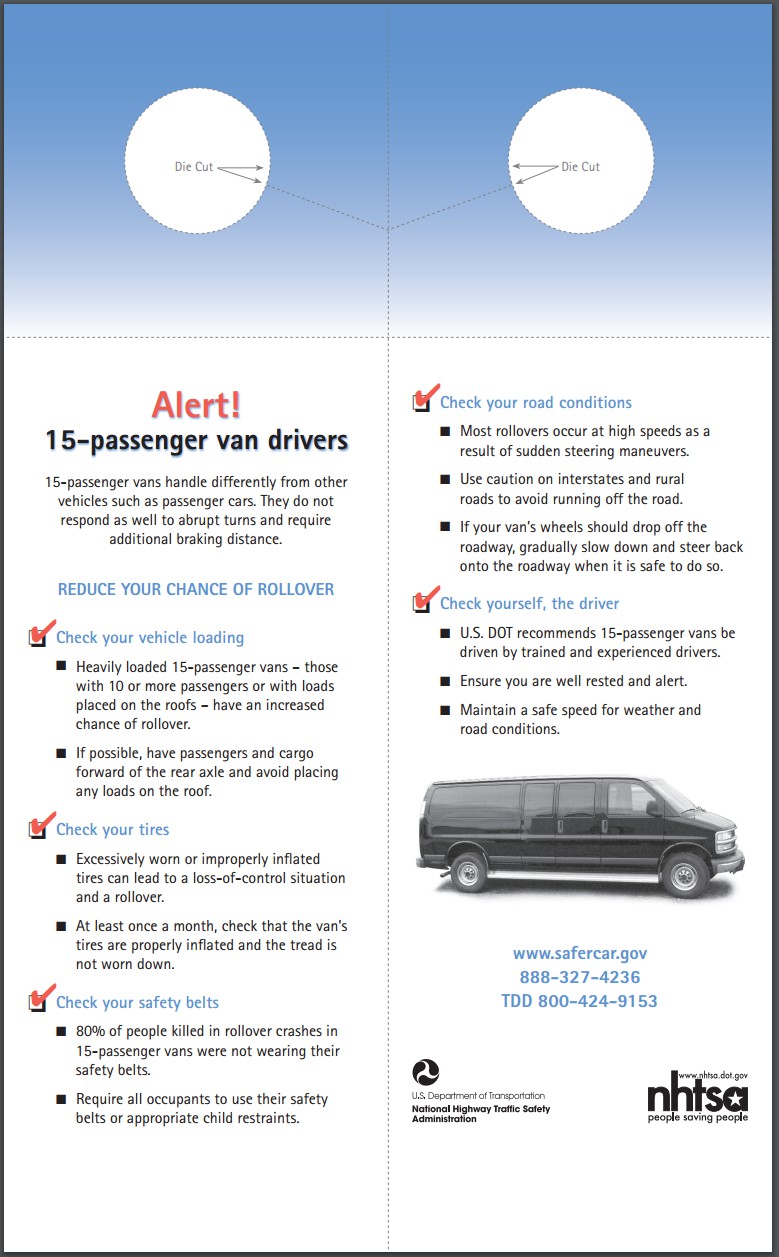
Appendix E
“Reducing the Risk of Rollover Crashes in 15-Passenger Vans” Flier
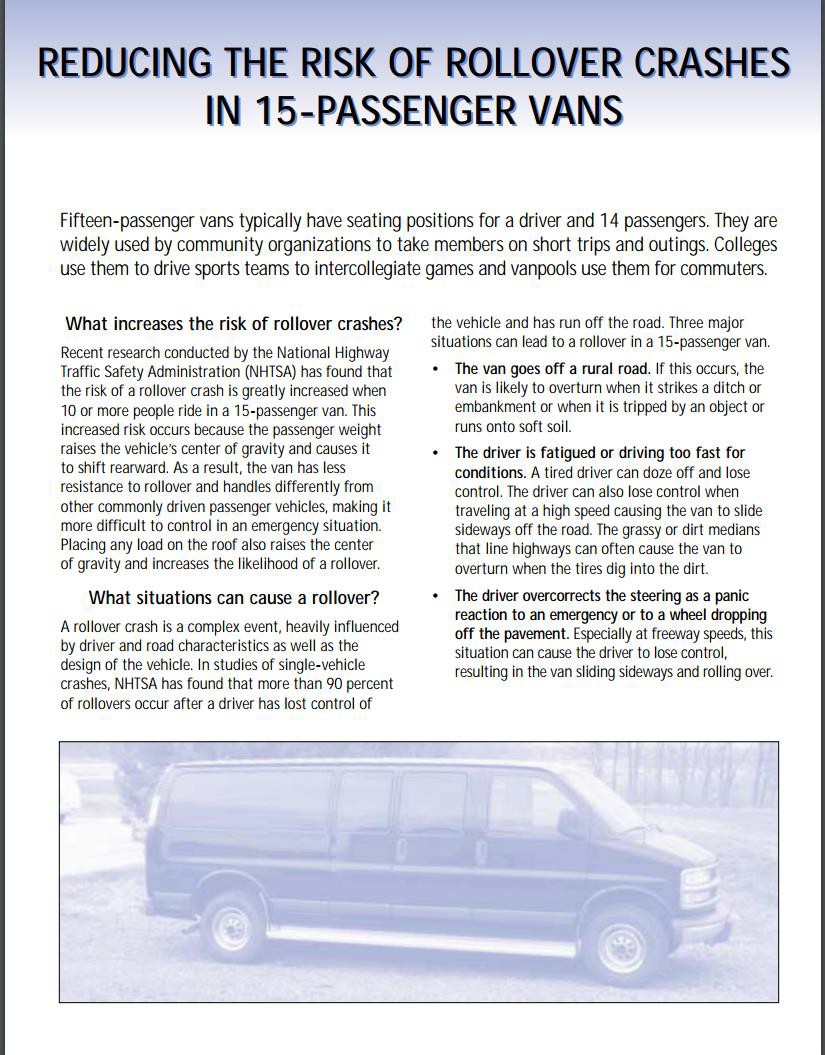
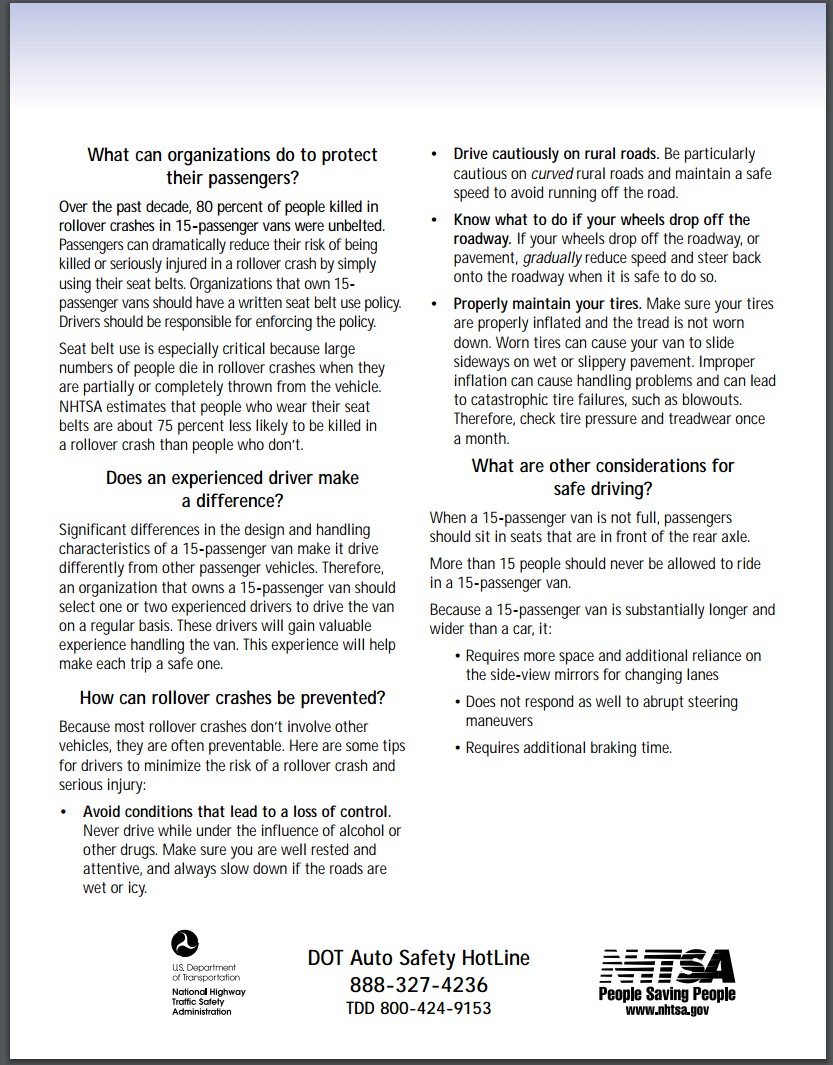
GS5104 – Motor Vehicle Safety Policy
Version: 2 // Effective: 03/18/2024
 Downloadable PDF
Downloadable PDF
Related Forms:
GS5104 – Appendix A – Acknowledgement of Policies Governing the Operation of University Vehicles
GS5104 – Appendix B – Vehicle Use Order Form
GS5104 – Appendix C – Driver’s Report of Vehicle Accident
GS5104 – Appendix D – “Reducing the Risk of Rollover Crashes in 15-Passenger Vans” Hang Tag
GS5104 – Appendix E – “Reducing the Risk of Rollover Crashes in 15-Passenger Vans” Flier






